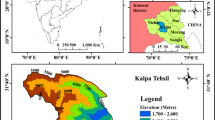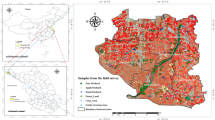Abstract
Horticultural crops are one of the vital role players in the field of economic development in Indian hilly regions. Among all, apple is one of the important horticulture crop in the North-West Himalaya, and 60% of apple production comes from Kashmir state in India. The identification and monitoring of apple becomes essential for proper assessment and planning for large production of apple. Now-a-days, Remote Sensing and GIS have been emerging as the newest and more advanced technique for crop monitoring, crop inventory and the assessment of its production. Kee** in view, the present work deals with the identification of apple-producing areas and assessment of phenology patterns of apple trees in Shopian district of Jammu and Kashmir which is a leading producer of apple in the whole world. The IRS-P6 LISS-IV, Cartosat-1 and LANDSAT-8 data were used for phenology and classification. Top of Atmospheric (TOA) correction and various digital classification algorithms viz., supervised MXL, Unsupervised ISODATA and NDVI threshold were used for estimation of the apple orchard area and NDVI profile for phenology pattern across the years. In comparison to other classification techniques, Supervised classification technique was found most suited with having accuracy ranging between 90 and 95% for all stages of apple trees. On the basis of spectral response and NDVI response, apple orchards were distinguishable amidst the other crops/vegetation types. Generated normalized difference vegetation index value was found to be 0.65 for apple orchards for LISS-IV and the results are used for finding the phenology of apple tree. Using the above NDVI threshold value, the apple orchards are classified with an accuracy range of 75–80%. It shows the unique spectral and phenology feature of apple and highlighted the seasonal change. This method is also very useful for other orchard inventory and estimation of productivity. Besides, this also provides a trend in any abnormal seasonal change on horticulture area which may help in providing pre-information about health and effect on overall production of orchard.
Access this chapter
Tax calculation will be finalised at checkout
Purchases are for personal use only
Similar content being viewed by others
References
Becker-Reshef I, Justice C, Sullivan M, Vermote E, Tucker C, Anyamba A, Small J, Pak E, Masuoka E, Schmaltz J, Hansen M (2010) Monitoring global croplands with coarse resolution earth observations: the global agriculture monitoring (GLAM) project. Remote Sensing 2(6):1589–1609
Bhat TA, Lone TA (2017) Potential and prospects of J&K economy. Educreation Publishing, New Delhi
Harris SA, Robinson JP, Juniper BE (2002) Genetic clues to the origin of the apple. Trends Genet 18(8):426–430
Hebbar R, Ravishankar HM, Subramoniam SR, Uday R, Dadhwal VK (2014) Object oriented classification of high-resolution data for inventory of horticultural crops. Int Arch Photogramm Remote Sens Spatial Inf Sci 40(8):745–749
Johansen K, Phinn S, Witte C, Philip S, Newton L (2009) Map** banana plantations from object-oriented classification of SPOT-5 imagery. Photogramm Eng Remote Sens 75(9):1069–1081
Kaul GL (1997) Horticulture in India-production, marketing and processing. Ind J Agric Econ 52(3):561–573
Koch E, Bruns E, Chmielewski F-M, Defila C, Lipa W, Menzel A (2007) Guidelines for plant phenological observations. World Climate Data and Monitoring Programme, Geneva
Lima ÁM, Cerqueira MA, Souza BW, Santos ECM, Teixeira JA, Moreira RA, Vicente AA (2010) New edible coatings composed of galactomannans and collagen blends to improve the postharvest quality of fruits–Influence on fruits gas transfer rate. J Food Eng 97(1):101–109
Panda SS, Hoogenboom G, Paz JO (2010) Remote sensing and geospatial technological applications for site-specific management of fruit and nut crops: a review. Remote Sensing 2(8):1973–1997
Polgar CA, Primack RB (2011) Leaf-out phenology of temperate woody plants: from trees to ecosystems. New Phytol 191(4):926–941
Ramírez F, Davenport TL (2013) Apple pollination: a review. Sci Hortic 162:188–203
Sadoulet E, De Janvry A (1995) Quantitative development policy analysis, vol 1. Johns Hopkins University Press, Baltimore
Schofield V (2000) Kashmir in conflict: India, Pakistan and the unending war. IB Tauris, London
Sharma A, Panigrahy S (2007) Apple orchard characterization using remote sensing and GIS in Shimla district of Himachal Pradesh. In Proceedings of remote sensing and photogrammetry annual conference 2007, pp. 11–14.
Suresha M, Shilpa NA, Soumya B (2012) Apples grading based on SVM classifier. Int J Comput Appl 975:8878
Tompkins JA, White JA, Bozer YA, Tanchoco JMA (2010) Facilities planning. Wiley, New York
Usha K, Singh B (2013) Potential applications of remote sensing in horticulture—a review. Sci Hortic 153:71–83
Way RD, Aldwinckle HS, Lamb RC, Rejman A, Sansavini S, Shen T, Watkins R, Westwood MN, Yoshida Y (1991) Apples (Malus). Genetic Resour Temperate Fruit Nut Crops 290:3–46
Xu D, Guo X (2014) Compare NDVI extracted from Landsat 8 imagery with that from Landsat 7 imagery. Am J Remote Sens 2(2):10–14
Acknowledgements
We thank Director of Regional Remote Sensing Center-South (RRSC-S), Bengaluru for providing required support to conduct the study and thank to NRSC/ISRO for data support.
Author information
Authors and Affiliations
Editor information
Editors and Affiliations
Rights and permissions
Copyright information
© 2022 The Author(s), under exclusive license to Springer Nature Singapore Pte Ltd.
About this chapter
Cite this chapter
Pandey, A., Hebbar, R., Palni, S., Rawat, J.S., Raj, U. (2022). Inventory and Phenological Assessment of Apple Orchards Using Various Remote Sensing Techniques for Shopian District of Jammu and Kashmir State, India. In: Singh, R.B., Kumar, M., Tripathi, D.K. (eds) Remote Sensing and Geographic Information Systems for Policy Decision Support. Advances in Geographical and Environmental Sciences. Springer, Singapore. https://doi.org/10.1007/978-981-16-7731-1_16
Download citation
DOI: https://doi.org/10.1007/978-981-16-7731-1_16
Published:
Publisher Name: Springer, Singapore
Print ISBN: 978-981-16-7730-4
Online ISBN: 978-981-16-7731-1
eBook Packages: Earth and Environmental ScienceEarth and Environmental Science (R0)




